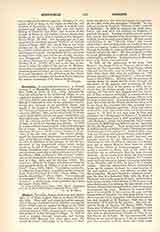

Giocondo, FRA GIOVANNI, Italian architect, antiquary, archaeologist, and classical scholar, b. in Verona, c. 1445; d. in Venice (?), c. 1525. He became a Dominican at the age of eighteen and was one of the many of that order who became pioneers of the Renaissance; afterwards, however, he entered the Franciscan Order. Giocondo began his career as a teacher of Latin and Greek in Verona where Scaliger was one of his pupils. The young priest, a learned archaeologist and a superb draughtsman, early visited Rome, sketched its ancient buildings, wrote the story of its great monuments, and completed and explained many defaced inscriptions. He stimulated the revival of classical learning by making collections of ancient MSS., one of which, completed in 1492, he presented to Lorenzo de’ Medici. Giocondo soon returned to his native town where he built bridges and planned fortifications for Treviso, acting as architect, engineer, and even head-builder during the construction. The most beautiful building in Verona and one of the most perfect in all Europe, the Palazzo del Consiglio, the decorations of whose loggia are famous, was designed by Giocondo at the request of Emperor Maximilian, and de Quincey attributes also the church of Santa Maria della Scala to him. Venice then summoned him with other celebrated architects to discuss the protection of the lagoons against the rivers; Giocondos plan of altering the Brentas bed and leading this river to the sea was accepted by the Venetians, and the undertaking was a complete success.
Between 1496 and 1499 Giocondo was invited to France by the king, and made royal architect. There he built two bridges of remarkable beauty, the Pont Notre-Dame and the Petit Pont, and designed the palace of the Chambre des Comptes, the Golden Room of the Parliament, and the Chateau of Gaillon (Normandy), one facade of which has been removed to the Ecole des Beaux Arts to serve as a model for students of architecture. In France Giocondo discovered a manuscript of Pliny the Younger, containing his correspondence with Trajan. He published this in Paris, dedicating the work to Louis XII. Between 1506 and 1508 he returned to Italy, wrote four dissertations on the waters and waterways of Venice and constructed the splendid Fondaco dei Tedeschi (1508), decorated by Titian and Giorgione. When in 1513 the Rialto and its environs were burned, Giocondo was one who presented plans for a new bridge and surrounding structures, but he left Venice for Rome when the designs of a rival (Michelangelo?) were chosen by the republic for which he had done such monumental work. The Vatican welcomed him (1514) and on Bramante’s death he superintended (with Raphael and San Gallo) the erection of St. Peter’s; but it was Fra Giocondo alone who improved and strengthened the foundations of the great basilica and the piers inadequately supporting its dome.
Two Italian editions of Pliny’s “Epistles” were published by Giocondo, one printed in Bologna (1498) and one from the press of Aldus Manutius (1508). He edited Caesar’s “Commentaries” and made the first design (drawing) of Caesar’s bridge across the Rhine. He was among the first to produce a correct edition of Vitruvius, printed at Venice in 1511, illustrated with figures and dedicated to Pope Julius II; and published the works of Julius Obsequens, Aurelius Victor, and Cato’s “De re rustic’ a”. In addition to his classical and mathematical knowledge he was a master of scholastic theology. His last work was, probably, the rebuilding of the bridge of Verona (1521), for in a letter to Giuliano de’ Medici, in 1513, Giocondo then called himself “an old man”.
LEIGH HUNT

